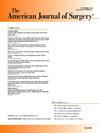评估指南不遵守对急性创伤情况下泌尿生殖系统损伤诊断的影响。
IF 2.7
3区 医学
Q1 SURGERY
引用次数: 0
摘要
背景:泌尿生殖系统损伤的延迟识别会对创伤患者造成重大伤害。尽管制定了指导方针,但不一致的坚持可能会增加这种风险。方法:我们访问了一个前瞻性管理的1级创伤中心数据库(2020-2023),用于尿外伤患者,评估美国泌尿学会尿外伤指南的依从性(GA)、不依从性(GNA)和漏伤(MI)率。结果:387例患者(411例)中,GNA发生率为33.6% (138/411),MI发生率为18.1%(25/138)。肾损伤为主,但引起心肌梗死的发生率低于输尿管损伤。大多数GNA病例包括遗漏尿液分析或血尿文件(45.7%)或遗漏随访影像(20.3%)。在MI患者中,与GA患者相比(p < 0.001), 72%的患者需要延迟泌尿系统干预(发病后中位5.5天),再入院率为12%(3/25)。结论:超过三分之一的病例发生GNA;近五分之一的患者进展为心肌梗死,这显著增加了延迟手术干预的可能性,并延长了干预时间。加强对泌尿创伤指南的机构遵守可以减少漏诊损伤并改善预后。本文章由计算机程序翻译,如有差异,请以英文原文为准。
Assessing the impact of guideline non-adherence on the diagnosis of genitourinary injuries in acute trauma settings
Background
Delayed recognition of genitourinary injuries can cause significant harm in trauma patients. Despite established guidelines, inconsistent adherence may increase this risk.
Methods
We accessed a prospectively-managed Level 1 trauma center database (2020–2023) for patients with urotrauma, assessing American Urological Association Urotrauma Guideline adherence (GA), non-adherence (GNA), and missed injury (MI) rates.
Results
Of 387 patients (411 injuries), GNA occurred in 33.6 % (138/411), with MI in 18.1 % (25/138). Renal injuries predominated but caused fewer MI than ureteral injuries. Most GNA cases involved missing urinalysis or hematuria documentation (45.7 %) or omitting follow-up imaging (20.3 %). Among MI, 72 % required delayed urologic intervention (median 5.5 days post-presentation) compared to GA (p < 0.001) with a readmission rate of 12 % (3/25).
Conclusions
GNA occurred in over one-third of cases; nearly one-fifth progressed to MI, which carried a significantly increased likelihood of delayed surgical intervention and longer time to intervention. Strengthening institutional adherence to urotrauma guidelines could reduce missed injuries and improve outcomes.
求助全文
通过发布文献求助,成功后即可免费获取论文全文。
去求助
来源期刊
CiteScore
5.00
自引率
6.70%
发文量
570
审稿时长
56 days
期刊介绍:
The American Journal of Surgery® is a peer-reviewed journal designed for the general surgeon who performs abdominal, cancer, vascular, head and neck, breast, colorectal, and other forms of surgery. AJS is the official journal of 7 major surgical societies* and publishes their official papers as well as independently submitted clinical studies, editorials, reviews, brief reports, correspondence and book reviews.

 求助内容:
求助内容: 应助结果提醒方式:
应助结果提醒方式:


